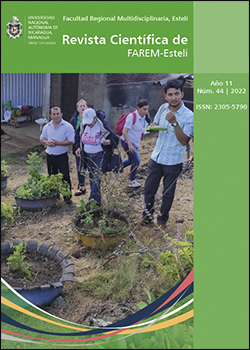Socioeconomic factors influencing the competitiveness of clothing and footwear businesses in Estelí, Nicaragua
DOI:
https://doi.org/10.5377/farem.v11i44.15688Keywords:
Characterization, competitiveness, positioning, socioeconomic factors, human talentAbstract
This research was carried out in the city of Esteli in the first semester of the year 2022. Owners of clothing and footwear businesses registered in the Municipal Mayor’s Office of Estelí participated. The purpose of the study was to characterize the socioeconomic factors that influence the competitiveness of clothing and footwear businesses in Estelí, Nicaragua. The socioeconomic characterization of the owners included the economic and organizational elements of the businesses and their collaborators. The study was justified by its convenience given that it has theoretical value, practical utility, and social relevance. Methodologically, it is a causal and applied research, approaching the perspective from a quantitative approach. The universe consisted of 250 businesses; the information was collected by applying the survey and interview methods in which two samples were used: the first was a simple random probabilistic sample of 53 owners used in the survey; the second was a sample of 10 owners used in the interview. The results reflect businesses mostly managed by the owners, between 18 and 40 years of age, predominantly female, with little experience and training, no union organization and high family participation. Economically and organizationally, most are individual microenterprises, without their own premises, small inventories, with financing from the government, private banks and financial institutions. The human talent is comprised mostly of young people, with a high school and higher education level and little training. These factors are determining factors in competitiveness and market positioning.
Downloads
References
Arceo Moheno, G., Almeida Aguilar, M., Yedra, R., & Acosta de la Cruz, J. (2017). La gestión de conocimiento y competitividad: un estudio en las empresas del sector servicios de los municipios de Cárdenas y Y Huimanguillo, Tabasco, México. Pretium, Revista de Economía, Finanzas y Negocios, 7(1), 9-16. Recuperado el 15 de marzo de 2021, de http://web.b.ebscohost.com/ehost/pdfviewer/pdfviewer?vid=18&sid=1c80a497-11f4-4899-8098-e0e777f2293f%40pdc-v-sessmgr01
Asamblea Nacional de Nicaragua. (08 de Febrero de 2008). Ley de promoción, fomento y desarrollo de la micro, pequeña y media empresa (Ley MIPYME), ley N° 645. Obtenido de http://legislacion.asamblea.gob.ni/normaweb.nsf/9e314815a08d4a6206257265005d21f9/ec29253dd104d7d30625741d005c6c8c?OpenDocument
Bravo García , S., Donado, A., Prieto Pulido, R., Duran, S. E., & Salazar Araujo, E. (2017). MiPyMEs asociadas y no asociadas: una aproximación a su gestión en innovación y desarrollo tecnológico. Espacios, 38(58). Obtenido de https://www.revistaespacios.com/a17v38n58/a17v38n58p17.pdf
Buitrago Mejía, A., Rodríguez Barrero, M. S., & Serna Gómez , H. (junio de 2019). Modelo de evaluación de la gestión y competitividad. PODIUM, 35, 97-118. doi:https://doi.org/10.31095/podium.2019.35.7
Castillo, R. (20 de Octubre de 2010). Grandes Pymes. Recuperado el 19 de Octubre de 2020, de Grandes Pymes: http://www.grandespymes.com.ar/2010/06/18/realidad-pyme-en-nicaragua/
Centeno Caffarena, L. (2009). Situación Global de las Pymes en Nicaragua. Recuperado el 20 de Octubre de 2020, de https://www.yumpu.com: https://www.yumpu.com/es/document/read/38189274/las-pymes-en-nicaragua-entorno-virtual-de-aprendizaje
Díaz, T., & Sánchez, G. (2014). Las Mipymes como base de la economía nacional. Recuperado el 20 de Octubre de 2020, de https://es.scribd.com/document/338676796/El-Observador-Economico
Gobierno de Reconciliación y Unidad Nacional. (1 de Julio de 2021). Plan de lucha contra la pobreza y para el desarrollo humano 2022-2026. Obtenido de https://www.pndh.gob.ni/documentos/pnlc-dh/PNCL-DH_2022-2026(19Jul21).pdf
Inciarte, A., Marcano, N., & Reyes, M. E. (2006). Gestión académico-administrativa en la educación básica. Revista Venezolana de Gerencia, 11(34), 230-231. Obtenido de https://www.redalyc.org/pdf/290/29003405.pdf
Kotler, P., & Armstrong, G. (2008). Fundamentos de Marketing (Octava ed.). (G. R. Miguel, Ed.) México: Pearson Educación de Mexico, S. A. de C. V.
Luna, J. E. (2012). Influencia del capital humano para la competitividad de las pymes en el sector manufacturero de Celaya, Guanajuato. (F. U. Garcilaso, Ed.) Recuperado el 29 de Octubre de 2020, de Edumed.net: https://www.eumed.net/tesis-doctorales/2013/jelc/jelc.pdf
Ministerio de Fomento, Industria y Comercio- MIFIC. (2010). Estudio de Ordenamiento de Mercados. Managua. Obtenido de https://unctadcompal.org/wp-content/uploads/2017/03/NICARAGUA-Estudio-de-ordenamiento-de-mercados_medidas-para-la-organizacion-del-comercio-interior.pdf
Mintzberg, H., Quinn, J. B., & Voyer, J. (1997). El Proceso Estratégico. México: Prentice Hall Hispanoamericana,S. A. .
Mora Gómez, N. A. (2008). ¿Es la gestión del talento humano un factor de competitividad en las pymes en la ciudad de pasto? (U. Mariana, Ed.) Revista UNIMAR, 26(2). Recuperado el 12 de Septiembre de 2020, de http://editorial.umariana.edu.co/revistas/index.php/unimar/article/view/86
Organización Internacional del Trabajo. (2017). La mujer en la gestión empresarial: Cobrando impulso en América Latina y el Caribe. Obtenido de https://www.ilo.org/public/spanish/dialogue/actemp/downloads/events/2017/lima_conf/wibm_fullreport_2017_sp.pdf
Prieto Castellanos, B. J. (15 de Diciembre de 2017). El uso de los métodos deductivo e inductivo para aumentar la eficiencia del procesamiento de adquisición de evidencias digitales*. Scielo. Recuperado el 21 de Agosto de 2020, de http://www.scielo.org.co/pdf/cuco/v18n46/0123-1472-cuco-18-46-00056.pdf
Quiala-Tamayo, L., Fernández Nápoles, Y., Vallín-García, A. E., Lopes Martínez, I., Domínguez-Pérez, F., & Calderio Rey, Y. (2018). Una nueva visión en la gestión de la logística de aprovisionamientos en la industria biotecnológica cubana. VacciMonitor. Recuperado el 12 de Octubre de 2020, de https://www.medigraphic.com/pdfs/vaccimonitor/vcm-2018/vcm183c.pdf
Rubio Domínguez , P. (2011). Introducción a la Gestión Empresarial. INSTITUTO EUROPEO DE GESTIÓN EMPRESARIAL. Recuperado el 02 de Septiembre de 2020, de http://www.adizesca.com/site/assets/g-introduccion_a_la_gestion_empresarial-pr.pdf
Saavedra Garcia, M. L., Tapia Sanchez, B., & Aguilar Anaya, M. d. (Septiembre de 2016). La gestión financieraen las pymes del Distrito Federal, Mexico. (researchgate.net/publication, Ed.) Revista Perspectiva Empresarial, 3(2), 55-69. doi:10.16967/rpe.v3n2a5
Van der Kamp, R. (2006). Pymes, competitividad y SDE en Nicaragua : un resumen cuantitativo. (Nitlapan, Ed.) Recuperado el 20 de Octubre de 2020, de http://biblioteca.clacso.edu.ar/Nicaragua/iid-uca/20170417031446/pdf_292.pdf
Published
Issue
Section
License
Copyright (c) 2023 Revista Científica de FAREM-Esteli

This work is licensed under a Creative Commons Attribution-NonCommercial-ShareAlike 4.0 International License.



